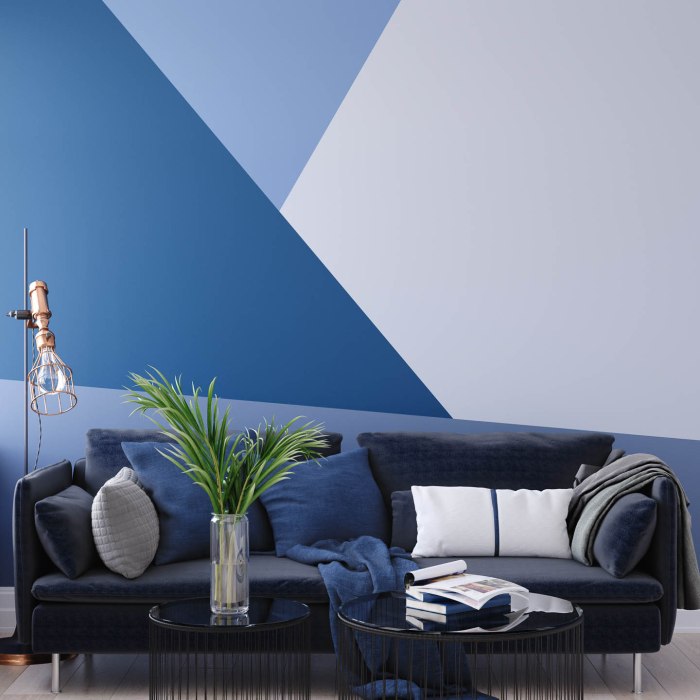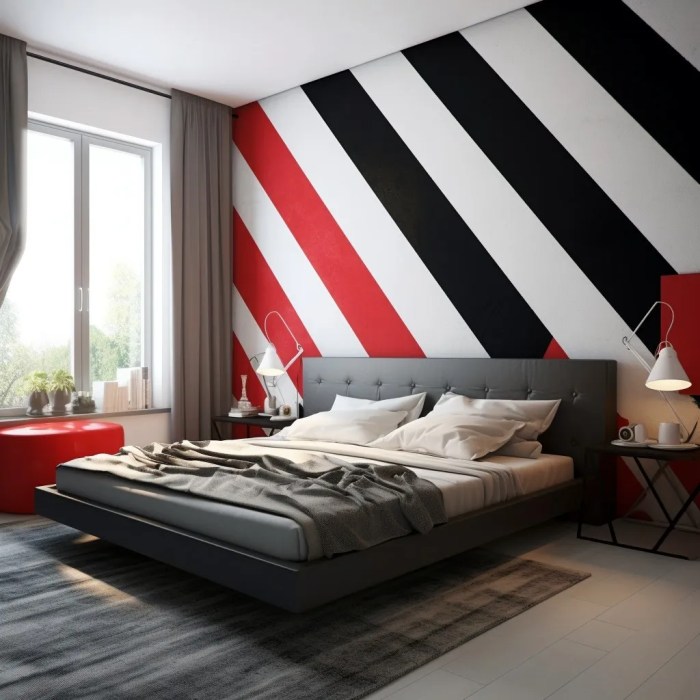Choosing the Right Painting Designs for Room: A Comprehensive Guide
Embark on a journey into the world of painting designs for room, where colors and patterns can transform spaces into works of art. From creating an atmosphere to playing with dimensions, the impact of choosing the right designs is profound.
In this guide, we delve into the importance of selecting the perfect painting designs for each room in your home, exploring popular choices, color palettes, and creative techniques to elevate your space.
Importance of Choosing the Right Painting Designs for a Room
Choosing the right painting designs for a room is crucial as it can significantly impact the overall look and feel of the space. The colors, patterns, and textures of the paint can influence the mood, perception of size, and even the functionality of the room.
How Painting Designs Influence the Mood of a Room
The color scheme of a room can evoke different emotions and set the tone for the space. For example, warm colors like reds, oranges, and yellows can create a cozy and inviting atmosphere, while cool colors like blues and greens can promote calmness and relaxation.
Bold and vibrant colors can add energy and personality to a room, while neutral tones can create a sense of tranquility.
Effect of Different Painting Designs on Room Size
Painting designs can also play a role in how spacious a room appears. Light colors tend to make a room feel larger and more open, while dark colors can create a more intimate and enclosed feeling. Vertical stripes can make a room appear taller, while horizontal stripes can make it seem wider.
Using paint to create an accent wall can draw the eye and add visual interest, making the room feel dynamic and engaging.
Impact of Color Psychology in Selecting Painting Designs
Color psychology is the study of how colors affect human behavior and emotions. When choosing painting designs for a room, it's important to consider the psychological effects of different colors. For example, blue is often associated with calmness and productivity, making it a good choice for bedrooms or home offices.
Yellow can promote happiness and energy, making it suitable for kitchens or playrooms. Understanding color psychology can help create a harmonious and balanced environment in the room.
Explore popular painting designs for different room types.

Choosing the right painting design for each room can significantly impact the overall ambiance and feel of the space. Let's explore some popular painting designs that work well in different room types.
Bedrooms
Bedrooms are often seen as a sanctuary for relaxation and rest. Therefore, it's essential to choose painting designs that promote a calming and soothing atmosphere. Some popular painting designs for bedrooms include:
- Soft pastel colors like light blue, lavender, or pale pink
- Neutral shades like beige, ivory, or light grey
- Muted earth tones such as sage green, soft brown, or warm taupe
Living Rooms
The living room is a space where people gather and socialize, so the painting design should be inviting and appealing. Some painting designs that work well in living rooms are:
- Warm and cozy colors like terracotta, burnt orange, or deep red
- Classic neutrals such as cream, camel, or light grey
- Bold accent walls in colors like navy blue, emerald green, or mustard yellow
Kitchens or Dining Areas
Kitchens and dining areas are often the heart of the home, where meals are shared and memories are made. Painting designs for these spaces should be vibrant and energizing. Some ideal painting designs for kitchens or dining areas include:
- Bright and cheerful colors like sunshine yellow, apple green, or sky blue
- Crisp whites or light greys to create a clean and fresh look
- Subtle pops of color through accessories or accent walls
Home Offices or Study Rooms
Home offices or study rooms are spaces where focus and productivity are key. The painting design should be conducive to work and concentration. Some unique painting designs for home offices or study rooms are:
- Soothing shades of green or blue to promote calmness and concentration
- Soft neutrals like pale grey, ivory, or light beige for a clean and minimalistic look
- Energizing colors like bright yellow or orange for creativity and inspiration
Detail the process of choosing the right color palette for room painting designs.
When selecting a color palette for room painting designs, it is essential to consider various factors to ensure that the colors complement each other and create the desired atmosphere. Here are some steps to guide you through the process:
Matching painting designs with existing furniture and decor
Before choosing a color palette, take into account the existing furniture and decor in the room. Consider the colors, patterns, and styles of these elements to ensure that the painting designs will harmonize with the overall aesthetic of the space.
You can either choose colors that complement the existing decor or opt for contrasting shades to create a striking visual impact.
Role of natural light and room size in selecting colors for painting designs
Natural light and room size play a crucial role in determining the right color palette for painting designs. Rooms with ample natural light can accommodate darker hues, while smaller rooms may benefit from lighter shades to create a sense of spaciousness.
Consider how the light affects the colors throughout the day and choose tones that will enhance the room's ambiance.
Tips on creating a cohesive color scheme for room painting designs
- Start by selecting a primary color that will serve as the foundation for the color palette.
- Choose two to three additional colors that complement the primary hue and create visual interest.
- Consider the 60-30-10 rule, where 60% of the room is the dominant color, 30% is the secondary color, and 10% is an accent color for balance.
- Experiment with different shades and tones within the chosen color palette to add depth and dimension to the room.
- Test sample swatches on the walls to see how the colors interact with the room's lighting before making a final decision.
Elaborate on creative techniques for painting designs to add depth and texture.

Adding depth and texture to painting designs can elevate the overall look of a room, creating visual interest and dimension. There are various creative techniques that can be employed to achieve this effect.
Use of Accent Walls in Room Painting Designs
Accent walls are a popular way to add depth and texture to a room through painting designs. By painting one wall in a contrasting color or using a different finish, you can create a focal point that draws the eye and adds visual interest to the space.
Incorporating Geometric Patterns or Stripes
Geometric patterns or stripes can also be used to add depth and texture to painting designs. These patterns can create visual illusions, making the walls appear larger or adding a sense of movement to the room. By using tape to create clean lines, you can achieve a crisp and modern look.
Using Stencils or Tape for Intricate Designs
Stencils and tape can be used to create intricate painting designs that add texture and dimension to the walls. By carefully applying paint through a stencil or using tape to create patterns, you can achieve a detailed and customized look that adds a unique touch to the room.
Examples of Faux Finishes or Textures
Faux finishes and textures can also be used to create unique painting designs that add depth to a room. Techniques such as sponge painting, rag rolling, or faux marble can create the appearance of texture and depth, giving the walls a rich and luxurious look.
Summary
As you navigate through the realm of painting designs for room, remember that your choices hold the power to shape the ambiance and style of your living spaces. Embrace the creativity and possibilities that come with each stroke of the brush, and let your rooms reflect your unique personality and taste.
Key Questions Answered
How do painting designs influence the mood of a room?
Painting designs can evoke various emotions based on colors and patterns used. Bright colors can create a lively atmosphere, while muted tones offer a sense of calmness.
What painting designs work well in kitchens or dining areas?
For kitchens and dining areas, consider using warm and inviting colors like yellows or earth tones. Simple patterns or textured finishes can add visual interest without overwhelming the space.
How can natural light and room size impact color choices for painting designs?
Natural light can affect how colors appear in a room. In smaller spaces, lighter shades can make the room feel more open, while in larger rooms, darker colors can create a cozier atmosphere.